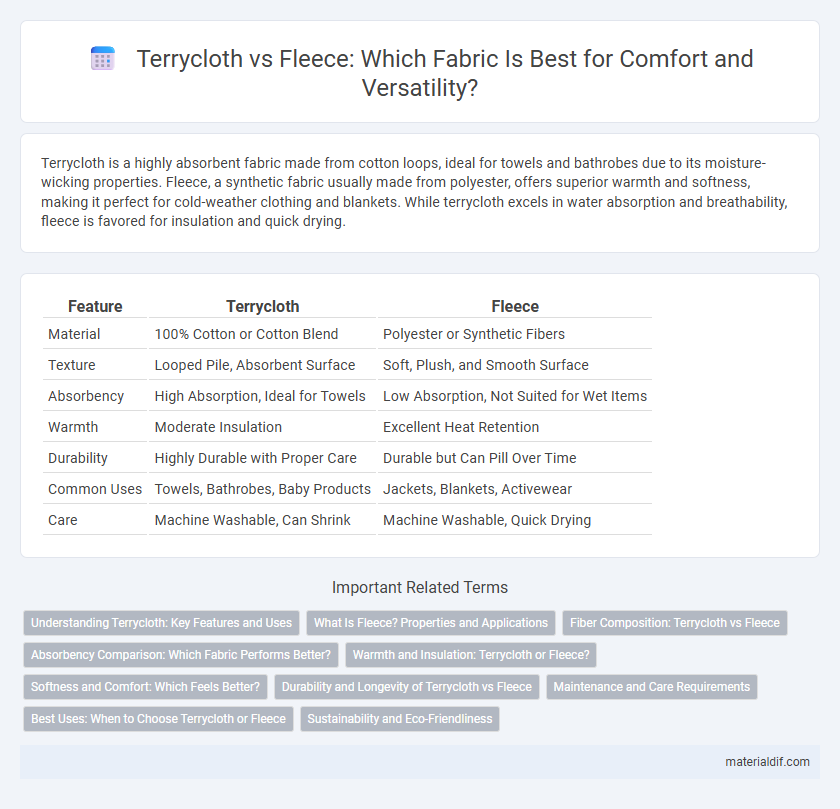Terrycloth is a highly absorbent fabric made from cotton loops, ideal for towels and bathrobes due to its moisture-wicking properties. Fleece, a synthetic fabric usually made from polyester, offers superior warmth and softness, making it perfect for cold-weather clothing and blankets. While terrycloth excels in water absorption and breathability, fleece is favored for insulation and quick drying.
Table of Comparison
| Feature | Terrycloth | Fleece |
|---|---|---|
| Material | 100% Cotton or Cotton Blend | Polyester or Synthetic Fibers |
| Texture | Looped Pile, Absorbent Surface | Soft, Plush, and Smooth Surface |
| Absorbency | High Absorption, Ideal for Towels | Low Absorption, Not Suited for Wet Items |
| Warmth | Moderate Insulation | Excellent Heat Retention |
| Durability | Highly Durable with Proper Care | Durable but Can Pill Over Time |
| Common Uses | Towels, Bathrobes, Baby Products | Jackets, Blankets, Activewear |
| Care | Machine Washable, Can Shrink | Machine Washable, Quick Drying |
Understanding Terrycloth: Key Features and Uses
Terrycloth is a woven fabric characterized by its looped pile that enhances absorbency, making it ideal for towels, bathrobes, and spa wear. Its natural cotton composition provides breathability and softness, distinguishing it from fleece, which is typically polyester-based and designed for insulation. Terrycloth's durability and moisture-wicking properties contribute to its widespread use in activewear and home textiles where comfort and absorbency are essential.
What Is Fleece? Properties and Applications
Fleece is a synthetic fabric made from polyester fibers, renowned for its lightweight, insulating properties and moisture-wicking capabilities. It offers excellent warmth retention while remaining breathable and quick-drying, making it ideal for outdoor clothing, athletic wear, and blankets. Common applications include jackets, hoodies, and activewear, where comfort and thermal efficiency are essential.
Fiber Composition: Terrycloth vs Fleece
Terrycloth is traditionally made from 100% cotton, known for its absorbent loops that provide excellent moisture-wicking properties, making it ideal for towels and bathrobes. Fleece is typically constructed from synthetic fibers such as polyester, offering lightweight warmth and quick-drying abilities, commonly used in outdoor and activewear. The natural cotton fiber in terrycloth enhances breathability, while the polyester in fleece ensures durability and insulation performance.
Absorbency Comparison: Which Fabric Performs Better?
Terrycloth, made from looped cotton fibers, offers superior absorbency, making it ideal for towels and bathrobes due to its ability to hold large amounts of water quickly. Fleece, constructed from synthetic polyester, excels in moisture-wicking and drying speed but lacks the high absorbency levels found in terrycloth. For applications where maximum water absorption is critical, terrycloth consistently outperforms fleece in absorbency performance.
Warmth and Insulation: Terrycloth or Fleece?
Fleece offers superior warmth and insulation compared to terrycloth due to its synthetic fibers that trap heat more effectively. Terrycloth, made from cotton, provides moderate warmth but excels in moisture absorption and breathability. For cold-weather garments requiring maximum insulation, fleece is the optimal fabric choice.
Softness and Comfort: Which Feels Better?
Terrycloth offers a breathable, moisture-wicking texture with looped fibers that provide plush softness, making it ideal for towels and bathrobes. Fleece, made from synthetic fibers like polyester, delivers exceptional warmth and a smooth, velvety feel that enhances comfort for cold-weather apparel. The choice between terrycloth and fleece depends on desired softness and insulation, with fleece generally feeling warmer and softer against the skin.
Durability and Longevity of Terrycloth vs Fleece
Terrycloth offers superior durability and longevity compared to fleece due to its looped pile construction, which resists wear and maintains absorbency over time. Fleece, made from synthetic fibers like polyester, tends to pill and lose insulating properties after repeated washing. For long-term use, terrycloth's robust cotton fibers provide better resilience, making it ideal for frequently laundered items such as towels and bathrobes.
Maintenance and Care Requirements
Terrycloth requires regular washing with mild detergents and air drying to prevent shrinkage and maintain its absorbency, while avoiding bleach to preserve fabric softness. Fleece demands gentle washing in cold water to retain its insulating properties and prevent pilling, and tumble drying on low heat or air drying is recommended. Both fabrics benefit from avoiding fabric softeners to maintain texture and durability during maintenance.
Best Uses: When to Choose Terrycloth or Fleece
Terrycloth is best for towels, bathrobes, and swimwear because of its high absorbency and durability, making it ideal for moisture-wicking and drying applications. Fleece excels in cold-weather clothing, blankets, and outdoor gear due to its lightweight warmth, softness, and quick-drying properties. Choose terrycloth for water-related uses and fleece for insulation and comfort in chilly environments.
Sustainability and Eco-Friendliness
Terrycloth, made from natural cotton fibers, offers superior sustainability due to its biodegradability and renewable source, making it an eco-friendly choice compared to synthetic fleece, which often contains petroleum-based materials. Fleece, although lightweight and insulating, typically involves energy-intensive production and contributes to microplastic pollution during washing. Choosing organic or recycled fiber terrycloth enhances environmental benefits by reducing chemical use and landfill waste.
Terrycloth vs Fleece Infographic

 materialdif.com
materialdif.com